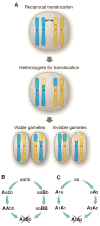Plant speciation
- PMID: 17702935
- PMCID: PMC2442920
- DOI: 10.1126/science.1137729
Plant speciation
Abstract
Like the formation of animal species, plant speciation is characterized by the evolution of barriers to genetic exchange between previously interbreeding populations. Prezygotic barriers, which impede mating or fertilization between species, typically contribute more to total reproductive isolation in plants than do postzygotic barriers, in which hybrid offspring are selected against. Adaptive divergence in response to ecological factors such as pollinators and habitat commonly drives the evolution of prezygotic barriers, but the evolutionary forces responsible for the development of intrinsic postzygotic barriers are virtually unknown and frequently result in polymorphism of incompatibility factors within species. Polyploid speciation, in which the entire genome is duplicated, is particularly frequent in plants, perhaps because polyploid plants often exhibit ecological differentiation, local dispersal, high fecundity, perennial life history, and self-fertilization or asexual reproduction. Finally, species richness in plants is correlated with many biological and geohistorical factors, most of which increase ecological opportunities.
Figures



Similar articles
-
Evolution of reproductive isolation in plants.Heredity (Edinb). 2009 Jan;102(1):31-8. doi: 10.1038/hdy.2008.69. Epub 2008 Jul 23. Heredity (Edinb). 2009. PMID: 18648386 Review.
-
Speciation genes in plants.Ann Bot. 2010 Sep;106(3):439-55. doi: 10.1093/aob/mcq126. Epub 2010 Jun 24. Ann Bot. 2010. PMID: 20576737 Free PMC article. Review.
-
Polyploidy and interspecific hybridization: partners for adaptation, speciation and evolution in plants.Ann Bot. 2017 Aug 1;120(2):183-194. doi: 10.1093/aob/mcx079. Ann Bot. 2017. PMID: 28854567 Free PMC article. Review.
-
A comparison of reproductive isolation between two closely related oak species in zones of recent and ancient secondary contact.BMC Evol Biol. 2019 Mar 6;19(1):70. doi: 10.1186/s12862-019-1399-y. BMC Evol Biol. 2019. PMID: 30841907 Free PMC article.
-
Ecological divergence plays an important role in strong but complex reproductive isolation in campions (Silene).Evolution. 2019 Feb;73(2):245-261. doi: 10.1111/evo.13652. Epub 2018 Dec 12. Evolution. 2019. PMID: 30499144
Cited by
-
Selection on meiosis genes in diploid and tetraploid Arabidopsis arenosa.Mol Biol Evol. 2015 Apr;32(4):944-55. doi: 10.1093/molbev/msu398. Epub 2014 Dec 26. Mol Biol Evol. 2015. PMID: 25543117 Free PMC article.
-
Molecular evidence for natural hybridization in the mangrove fern genus Acrostichum.BMC Plant Biol. 2013 May 1;13:74. doi: 10.1186/1471-2229-13-74. BMC Plant Biol. 2013. PMID: 23634934 Free PMC article.
-
Chromosome-level Genomes Reveal the Genetic Basis of Descending Dysploidy and Sex Determination in Morus Plants.Genomics Proteomics Bioinformatics. 2022 Dec;20(6):1119-1137. doi: 10.1016/j.gpb.2022.08.005. Epub 2022 Aug 30. Genomics Proteomics Bioinformatics. 2022. PMID: 36055564 Free PMC article.
-
The existence of species rests on a metastable equilibrium between inbreeding and outbreeding. An essay on the close relationship between speciation, inbreeding and recessive mutations.Biol Direct. 2011 Dec 9;6:62. doi: 10.1186/1745-6150-6-62. Biol Direct. 2011. PMID: 22152499 Free PMC article.
-
Post-zygotic selection against parental genotypes during larval development maintains all-hybrid populations of the frog Pelophylax esculentus.BMC Evol Biol. 2015 Jul 4;15:131. doi: 10.1186/s12862-015-0404-3. BMC Evol Biol. 2015. PMID: 26141702 Free PMC article.
References
-
- Arnold ML. Natural Hybridization and Evolution. Oxford Univ. Press; Oxford: 1997.
-
- Mishler BD, Donoghue MJ. Syst Zool. 1982;31:491.
-
- Ehrlich PR, Raven PH. Science. 1969;165:1228. - PubMed
Publication types
MeSH terms
Grants and funding
LinkOut - more resources
Full Text Sources

